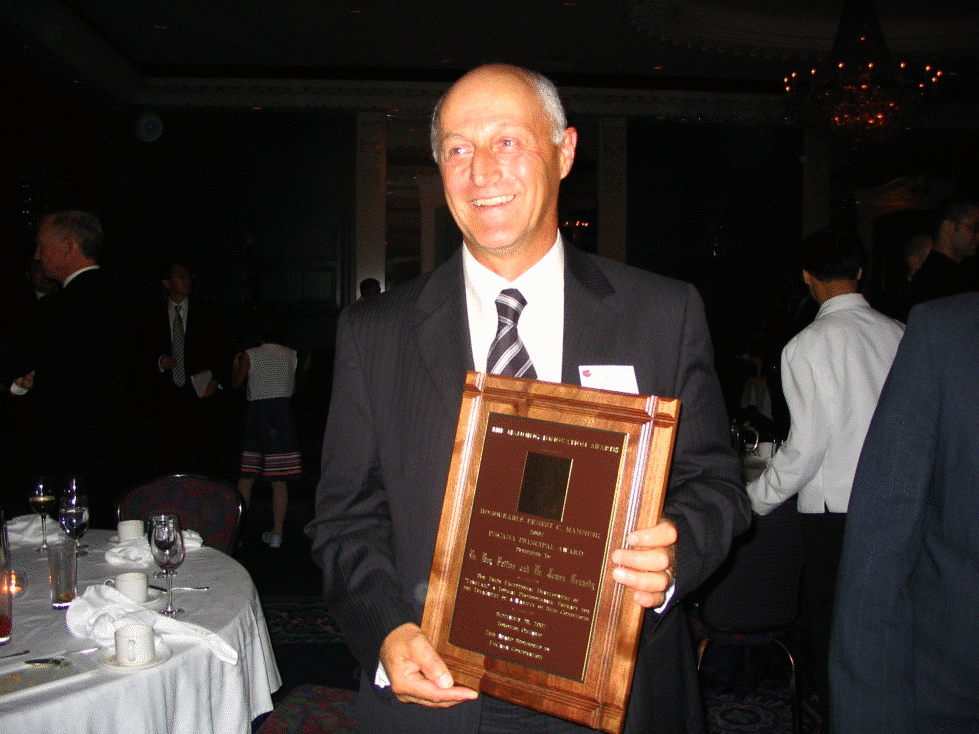
 RMC Professor Co-Winner of $100,000 Award for Groundbreaking ResearchBy Capt Paule Poulin, with files from the Manning Foundation
RMC Professor Co-Winner of $100,000 Award for Groundbreaking ResearchBy Capt Paule Poulin, with files from the Manning Foundation
Dr. Roy Pottier, PhD, a Professor Emeritus at RMC’s Department of Chemistry and Chemical Engineering received the prestigious $100,000 EnCana Principal Award from the Ernest C. Manning Awards Foundation at an awards gala on September 28th in Toronto, along with Dr. James Kennedy, Professor Emeritus at Queen’s Department of Oncology, for their pioneering work on photodynamic therapy.
The team discovered that 5-aminolevulinic acid (ALA) could be combined with light therapy to treat pre-cancerous and other skin conditions. This led to the development of Levulan® Photodynamic Therapy (PDT), used to successfully treat over 300,000 cases of the pre-cancerous skin condition, actinic keratosis. The therapy’s other uses include acne treatment, and is being investigated with various other skin conditions, cancers and infections.
Dr. Kennedy initially provided ALA-photodynamic therapy to a cancer-patient who was too weak for surgery, as well as others for whom conventional treatments had failed. The therapy worked and was easier to take compared to other treatments.
With other drugs, explained Dr. Pottier, “it’s a huge problem getting the drug to the site where you want it to work.” When Levulan®, the commercial formulation of ALA, is applied topically, it passes readily into the deeper layers of the skin where cancer cells originate.
Drs. Pottier and Kennedy carried out their research at the Royal Military College of Canada, Queen’s University and the Kingston General Hospital. They teamed up in 1979 in order to pursue basic and clinical research in photodynamic therapy.
It was the researchers’ close collaboration that moved their discovery forward. “We disagree on almost everything…except mutual respect,” commented Dr. Pottier. “We made a good team.”
This year the Ernest C. Manning Awards Foundation will award a total of $165,000 in prize money. Four awards, totalling $145,000, will go to leading Canadian innovators. Another $20,000 will go to Young Canadians chosen at the Canada-Wide Science Fair. The Foundation was established in 1980 in the name of Alberta statesman, Ernest C. Manning, to promote and support Canadian innovation. Since 1982, the Foundation has presented $3.76 million in prize money through its annual awards program.
Dr Pottier’s accomplishment is another example that RMC’s researchers and facilities are second-to-none.
Caption for picture (credit to Kathy Creber): Doctor Roy Pottier with his EnCana Principal Award in Toronto on 28 September 2007.
Un professeur du CMR corécipiendaire d’un prix de $100,000 pour sa recherche révolutionnaire
Par le Capt Paule Poulin, avec des dossiers de la Fondation Manning
Le Docteur Roy Pottier, PhD, professeur émérite au Département de chimie et génie chimique a reçu le prestigieux prix de 100 000$ “EnCana Principal”de la Fondation Ernest C. Manning lors d’un gala le 28 septembre à Toronto, partageant le prix avec le Docteur James Kennedy, professeur émérite au Département d’oncologie de Queen’s, pour leur travail original sur la thérapie photodynamique.
L’équipe a découvert que l’acide 5-aminolévulinque (ALA) pouvait être combiné avec la luminothérapie pour soigner les conditions pré-cancéreuses de la peau et autres. Ceci a mené au développement de la Thérapie photodynamique Levulan®, utilisée pour soigner avec succès plus de 300 000 cas de la condition pré-cancéreuse de la peau, kératose actinique. La thérapie est aussi utilisée pour le traitement de l’acné, et est présentement évaluée pour d’autres conditions de la peau, cancers et infections.
Le Docteur Kennedy a initialement administré la thérapie photodynamique-ALA à un patient atteint du cancer qui était trop faible pour une chirurgie, et à d’autres pour qui les traitements traditionnels avaient échoué. La thérapie a fonctionné et était plus facile à suivre comparé à d’autres traitements.
Avec certains autres médicaments, explique le Docteur Pottier, « c’est un énorme problème d’acheminer le médicament au site où vous voulez qu’il fonctionne ». Quand Levulan®, la formulation commerciale du ALA, est appliquée par la voie topique, elle passe aisément dans les plus profondes couches de la peau, lieu d’origine des cellules cancéreuses.
Les docteurs Pottier et Kennedy ont fait leurs recherches au Collège militaire royal du Canada, à l’université Queen’s et à l’Hopitâl Général de Kingston. Ils ont fait équipe à partir de 1979 pour poursuivre des recherches de base et clinique en thérapie photodynamique.
L’étroite collaboration des chercheurs a permis de faire avancer leur découverte. « Nous sommes en désaccord sur presque tout… à l’exception du respect mutuel », commente le Docteur Pottier. « Nous faisons une bonne équipe ».
Cette année la Fondation Ernest C. Manning va donner un total de165 000$ en bourses. Quatre prix, pour un total de 145 000$, vont être décernés à des innovateurs canadiens de premier plan. Un autre 20 000$ sera décerné à de jeunes canadiens choisis à l’Expo-sciences pancanadienne. La Fondation a été établie en 1980 au nom de l’homme d’état d’Alberta, Ernest C. Manning, pour promouvoir et supporter l’innovation canadienne. Depuis 1982, la Fondation a décerné 3.76$ million en bourses par le biais de son programme annuel de bourses.
L’accomplissement du Docteur Pottier est un autre exemple que les chercheurs et équipements du CMR sont hors-pairs.
Légende pour la photo (crédit à Kathy Creber): Le Docteur Roy Pottier avec son prix « EnCana Principal » à Toronto le 28 septembre 2007.
![]()

RMC site of -10th Annual CDAI Graduate Student Symposium on “Canada’s Security Interests – Lessons of History” on October 26 and 27, 2007.
The Conference of Defence Associations Institute (CDAI), in collaboration with the War Studies Programme of the Royal Military College (RMC) of Canada, Queen’s University, and with the financial support of General Dynamics Canada, David Scott, the Canadian Defence and Foreign Affairs Institute, and the DND-Sponsored Security and Defence Forum will host the 10th Annual CDAI Graduate Student Symposium on “Canada’s Security Interests – Lessons of History” on October 26 and 27, 2007. The Symposium will take place in Currie Hall at RMC in Kingston , Ontario . Click link for a map to this location:
The keynote speakers for this year’s Symposium are 5105 J.L. Granatstein (CMR / RMC ’61), Toronto-based historian, on Friday, October 26, and MGen D Gosselin, Commandant, Canadian Defence Academy , on Saturday, October 27. Cash prizes of $3000.00, $2000.00, and $1000.00 will be awarded to the top three papers presented at this year’s Symposium.
Registration is free and includes lunch on Friday and Saturday as well as a dinner on Friday night in the Cadet Mess at RMC. Registration forms and a draft agenda are available on CDAI website
![]()
“Three fjords under scientists’ microscope”
Article first appeared in the Montreal – The Gazette
Working in partnership with government agencies, universities and the Voisey Bay Nickel Co., RMC’s Environmental Services Group and Nunatsiavut, Labrador’s Inuit self-government, want a better picture of the current health of these sites and where they are most vulnerable to shifting weather patterns, melting sea ice, pollution and industrialization. During their stint aboard the Amundsen, RMC researchers Tanya Brown and Jacquie Bastick pitched in to collect water, phytoplankton and zooplankton samples. Now they’ll leave the ship to conduct land-based studies at Saglek and Nachvak fjords.
“There are three main concerns in the North right now – contaminants, climate change and industrialization,” Bastick said. Her master’s research project at Memorial University aims to provide Parks Canada with a report card on Nachvak, the jewel in Canada’s newest national reserve. Bastick, who spent five years in the Northwest Territories, says she also believes it’s important for scientists to have a broader understanding of how climate change is influencing different parts of the planet. For instance, while the Western Arctic has been warming significantly over the last two decades, studies suggest
parts of Labrador and northern Quebec are slightly colder than they used to be. “What might be a good solution for one area may not be right for another.”
Backgrounder
…
The Environmental Science Group (ESG) at RMC hires a number of undergraduate and graduate students each year who receive training and work in remote locations. ESG offers a cooperative education program: all postgrads must participate in some applied project work that is not directly related to their topic each year; in most cases thesis topics involve the solution of an applied problem.
